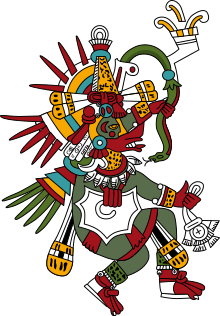Macuiltochtli
Macuiltochtli ("Five Rabbit"; from Nahuatl, macuilli, five, tochtli, rabbit) is one of the five deities from Aztec and other central Mexican pre-Columbian mythological traditions who, known collectively as the Ahuiateteo, symbolized excess, over-indulgence and the attendant punishments and consequences thereof.[1]
Macuiltochtli and the other Ahuiateteo —Macuilxochitl ("5 flower"), Macuilcuetzpalin ("5 lizard"), Macuilcozcacuahtli ("5 vulture"), and Macuilmalinalli ("5 grass")— bore the names of specific days in the tonalpohualli (Aztec/central Mexican version of the Mesoamerican 260-day calendar), where the day coefficient (trecena) of five had overtones associated with excess and loss of control. Postclassic central Mexican traditions identified rabbits with the beverage pulque and insobriety, and by extension Macuiltochtli had a particular association with inebriation and excessive consumption.[2]
Macuiltochtli was also part of the Centzon Totochtin, the four hundred rabbits which were all gods of drunkenness.
See also
- Ometotchtli, Two Rabbit, master of the Centzon Totochtin
- Mayáhuel, foremost of the Pulque Gods
- Tepoztécatl, a Pulque god associated with Tepoztlán
- Pulque
- Aztec mythology
Notes
- Miller and Taube (1993), p.40.
- Miller and Taube (1993), p.142.
References
- Aguilar-Moreno, Manuel (2007). Handbook to Life in the Aztec World. Oxford and New York: Oxford University Press. ISBN 978-0-19-533083-0. OCLC 81150666.
- Boone, Elizabeth Hill (2007). Cycles of Time and Meaning in the Mexican Books of Fate. Joe R. and Teresa Lozano Long series in Latin American and Latino art and culture. Austin: University of Texas Press. ISBN 978-0-292-71263-8. OCLC 71632174.
- Miller, Mary; Karl Taube (1993). The Gods and Symbols of Ancient Mexico and the Maya: An Illustrated Dictionary of Mesoamerican Religion. London: Thames & Hudson. ISBN 0-500-05068-6. OCLC 27667317.
- Sahagún, Bernardino de (1997) [ca.1558–61]. Primeros Memoriales. Civilization of the American Indians series vol. 200, part 2. Thelma D. Sullivan (English trans. and paleography of Nahuatl text), with H.B. Nicholson, Arthur J.O. Anderson, Charles E. Dibble, Eloise Quiñones Keber, and Wayne Ruwet (completion, revisions, and ed.). Norman: University of Oklahoma Press. ISBN 978-0-8061-2909-9. OCLC 35848992.
